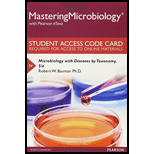
To explain:
The inference of eosinophils making up
Introduction:
White blood cells are also referred to as leukocytes. These are the part of immune system that are involved in protecting the body against foreign pathogens, infections, and diseases. White blood cells are derived from haemopoietic stem cells.
To explain:
The way through which suspicions would change if the patient had spent last three years as an anthropologist in African jungle.
Introduction:
The patient’s chart shows eosinophils make
To explain:
The normal percentage of eosinophils.
Introduction:
White blood cells are derived from haemopoietic stem cells. White blood cells are also referred to as leukocytes. These are the part of immune system and are involved in protecting the body against foreign pathogens, infections, and diseases.
Want to see the full answer?
Check out a sample textbook solution
Chapter 15 Solutions
Mastering Microbiology with Pearson eText -- Standalone Access Card -- for Microbiology with Diseases by Taxonomy (5th Edition)
- 1. Which of the following are granulocytes? 1. Neutrophils 2. Monocytes 3. Eosinophils 4. Lymphocytes 5. Basophils A. 2 only B. 5 only C. 2 and 4 only D. 1,3, and 5 onlyarrow_forwardWhich of the following is a leukocyte AND a lymphocyte? A. macrophage B. natural killer cell C. megacytoblast D. neutrophil E. eosinophilarrow_forwardChest x-rays give the lowest doses. Why?arrow_forward
- Which of the following blood cells function primarily as phagocytes?a. eosinophils b. basophils c. lymphocytes d. neutrophilsarrow_forwardI have a patient who is blood type B- and has received a blood donation from a blood type B- donor. Will the patient's immune system accept the red blood cells from the donor as "self" cells and allow the cells to live? Will the patient's immune system accept the white blood cells (B cells, T cells, etc) from the donor as "self" cells and allow the cells to live?arrow_forwardWhich statement is true? Statement 1: Antibodies are not specific for each type of antigen encountered by the body. Statement 2: Neutrophils are antigen-presenting cells.arrow_forward
 Comprehensive Medical Assisting: Administrative a...NursingISBN:9781305964792Author:Wilburta Q. Lindh, Carol D. Tamparo, Barbara M. Dahl, Julie Morris, Cindy CorreaPublisher:Cengage Learning
Comprehensive Medical Assisting: Administrative a...NursingISBN:9781305964792Author:Wilburta Q. Lindh, Carol D. Tamparo, Barbara M. Dahl, Julie Morris, Cindy CorreaPublisher:Cengage Learning Human Physiology: From Cells to Systems (MindTap ...BiologyISBN:9781285866932Author:Lauralee SherwoodPublisher:Cengage Learning
Human Physiology: From Cells to Systems (MindTap ...BiologyISBN:9781285866932Author:Lauralee SherwoodPublisher:Cengage Learning Human Heredity: Principles and Issues (MindTap Co...BiologyISBN:9781305251052Author:Michael CummingsPublisher:Cengage Learning
Human Heredity: Principles and Issues (MindTap Co...BiologyISBN:9781305251052Author:Michael CummingsPublisher:Cengage Learning





